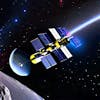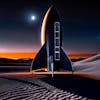S02E09 - NASA's Influence on Our Daily Life and UAE's Ambitious Mission to Asteroid Belt
Welcome to Astronomy Daily for the 29th of May 2023 – S02E09 In this episode, we talk about NASA's interesting influences on our daily life, some interesting inventions and developments that they've dumped on us over the years as well as something...
Welcome to Astronomy Daily for the 29th of May 2023 – S02E09 In this episode, we talk about NASA's interesting influences on our daily life, some interesting inventions and developments that they've dumped on us over the years as well as something that China has been developing and has been flying over our heads for the last nine months. We also discuss an asteroid that may host life's building blocks which will get a visit from a United Arab Emirates spacecraft about a decade from now if all goes according to plan. The UAE announced in October 2021 that it plans to launch an ambitious mission to the asteroid belt in 2028. That mission will visit seven different space rocks and even land on one of them, an asteroid called 269 Justisha. Sheikh Muhammad bin Rashid Al-Makhtum bin Rashid Al-Makhtum, the vice president and prime minister of the UAE and the ruler of Dubai, said in a statement that we will never cease to look ahead. We will never cease our efforts to develop a brighter future for our young generations.² Astronomy Daily – The Podcast is available on Apple Podcasts, Spotify, YouTube and wherever you get your podcasts. Apple Podcasts: https://podcasts.apple.com/us/podcast/astronomy-daily-the-podcast/id1642258990 Spotify: https://open.spotify.com/show/2kPF1ABBW2rCrjDlU2CWLW Or stream from our websites at www.spacenuts.io or our HQ at www.bitesz.com Astronomy Daily the Podcast now has its own YouTube channel – please subscribe (we’re a little lonely there) – thank you: www.youtube.com/@astronomydailythepodcast Commercial Free Premium version available with a Space Nuts subscription via Supercast only. Details: https://spacenuts.supercast.com/ Please subscribe to the podcast and if you have a moment, a quick review would be most helpful. Thank you… Please show our sponsor some love. Looking to buy a domain name and establish yourself online for not very much money? Then use the folks we trust all our domains too… NameCheap…and help support the show. To find out more visit www.spacenutspodcast.com/namecheap - thank you. #space #astronomy #science #podcast #astronomydaily #spacenuts #spacetime
1 00:00:00,000 --> 00:00:06,960 Welcome to Astronomy Daily for the 29th of May 2023. We've got some interesting things for you this afternoon 2 00:00:06,960 --> 00:00:12,840 or this evening or this morning where you might be catching us. We're going to be talking about 3 00:00:12,840 --> 00:00:21,080 NASA's interesting influences on our daily life, some interesting inventions and developments that they've dumped on us over the years 4 00:00:21,080 --> 00:00:27,760 as well as something that China has been developing and has been flying over our heads for the last nine months. 5 00:00:27,760 --> 00:00:29,760 Interesting and strange. 6 00:00:29,760 --> 00:00:41,200 Yes indeed, I'm Ziohoes Steve Dunkley for this afternoon. Would you welcome 7 00:00:41,200 --> 00:00:47,000 Halle our digital reporter? Hi Halle. Hi Steve. Did you find some interesting stories for us today? 8 00:00:47,000 --> 00:00:48,480 Yes, let's get into it. 9 00:00:54,040 --> 00:01:03,680 An asteroid that may host life's building blocks will get a visit from a United Arab Emirates spacecraft about a decade from now, if all goes according to plan. 10 00:01:03,680 --> 00:01:12,480 In October 2021, the UAE announced that it plans to launch an ambitious mission to the asteroid belt in 2028. 11 00:01:12,480 --> 00:01:21,000 That mission will visit seven different space rocks and even land on one of them, an asteroid called 269 Justisha. 12 00:01:21,000 --> 00:01:33,400 Sheikh Muhammad bin Rashid Al-Makhtum bin Rashid Al-Makhtum, the vice president and prime minister of the UAE and the ruler of Dubai, said in a statement that we will never cease to look ahead. 13 00:01:33,400 --> 00:01:38,440 We will never cease our efforts to develop a brighter future for our young generations. 14 00:01:38,440 --> 00:01:47,080 The EMA spacecraft will be named after the Sheik. It will be called the MBR Explorer and will visit its first asteroid in 2030 15 00:01:47,080 --> 00:01:52,920 and will follow an orbital path allowing it to pick up speed from several planets along the way. 16 00:01:52,920 --> 00:02:00,040 It's common for spacecraft to get such a gravity assists from worlds like Venus or Mars to save on fuel 17 00:02:00,040 --> 00:02:03,720 and to do side observations to test their instruments. 18 00:02:03,720 --> 00:02:12,840 After passing by six asteroids, the mission aims to touch down upon Justisha in 2034 with a small lander that it deploy. 19 00:02:12,840 --> 00:02:24,200 Justisha may have organic molecules on its surface, organics are the building blocks of the complex molecules that could form life in the right circumstances. 20 00:02:24,200 --> 00:02:32,360 The Airbus-built Arab-Sat-Bad-8 telecommunications satellite has been successfully launched from Cape Canaveral of Florida. 21 00:02:32,360 --> 00:02:45,080 Based on Airbus latest geostationary Eurostar Neo-Satellite, Bad-8 will provide connectivity for users across Europe, Middle East, Africa, and Central Asia. 22 00:02:45,080 --> 00:02:56,280 The spacecraft is also equipped with a world first, Airbus Innovative Space Demonstrator Tiliot to provide space to ground optical communications at Gigabit speeds. 23 00:02:56,280 --> 00:03:03,240 The Tiliot Demonstrator payload is designed to facilitate very high-capacity optical feeder link communications, 24 00:03:03,240 --> 00:03:11,080 playing a crucial role in Airbus development of a new generation of optical communications technology in space. 25 00:03:11,080 --> 00:03:16,760 Featuring increased payload capacity and more efficient power and thermal control systems, 26 00:03:16,760 --> 00:03:22,040 Bad-8 will replace and increase Arab-Sat's capacity. 27 00:03:22,040 --> 00:03:27,800 I was wondering when we were going to see some new lunar vehicles. Here we go, Steve. 28 00:03:27,800 --> 00:03:34,040 NASA is seeking industry proposals for a next-generation LTV lunar terrain vehicle. 29 00:03:34,040 --> 00:03:44,680 That will allow astronauts to go farther and conduct more science than ever before as they explore the South Polar Region of the Moon, during Artemis missions. 30 00:03:44,680 --> 00:03:52,520 Artemis astronauts will drive to explore and sample more of the lunar surface using the LTV than they could on foot. 31 00:03:52,520 --> 00:03:58,520 NASA will contract LTV as a service from industry rather than owning the rover. 32 00:03:58,520 --> 00:04:06,840 Contracting services from industry partners allows NASA to leverage commercial innovation and provide the best value to US taxpayers, 33 00:04:06,840 --> 00:04:12,040 while achieving its human spaceflight scientific and exploration goals. 34 00:04:12,040 --> 00:04:19,240 We want to leverage industry's knowledge and innovation, combined with NASA's history of successfully operating rovers, 35 00:04:19,240 --> 00:04:24,760 to make the best possible surface rover for our astronaut crews and scientific researchers, 36 00:04:24,760 --> 00:04:35,240 said Laura Kerney, manager of NASA's Extr-Vhicular Activity and Human Surface Mobility Program at the agency's Johnson Space Center, in Houston. 37 00:04:35,240 --> 00:04:42,280 The LTV will function like a cross between an Apollo-style lunar rover and a Mars-style uncrude rover. 38 00:04:42,280 --> 00:04:49,080 It will support phases driven by astronauts and phases as an uncrude mobile science exploration platform, 39 00:04:49,080 --> 00:04:53,960 similar to NASA's Curiosity and Perseverance Mars Rovers. 40 00:04:53,960 --> 00:05:00,440 This will enable continued performance of science even when crews are not present on the lunar surface. 41 00:05:00,440 --> 00:05:06,680 Artemis astronauts will use the LTV to traverse the lunar surface and transport scientific equipment, 42 00:05:06,680 --> 00:05:10,280 extending the distances they can cover on each moonwalk. 43 00:05:10,280 --> 00:05:13,720 And that's the short takes for today. 44 00:05:13,720 --> 00:05:23,240 Have you got something interesting and weird to share Steve? 45 00:05:23,240 --> 00:05:29,000 Yes, I did find a couple of interesting stories and this one involves the kinds of things that NASA 46 00:05:29,000 --> 00:05:32,040 have developed over the years and brought into our lives. 47 00:05:32,040 --> 00:05:34,280 I don't know why they're releasing this information. 48 00:05:34,280 --> 00:05:40,200 At the moment, I think they're trying to play catch-up with all of the millionaires out there making such wonderful headlines. 49 00:05:40,200 --> 00:05:41,320 Let's have a look at what they're saying. 50 00:05:41,320 --> 00:05:47,880 Now, although basic water filters had been in existence since the 1950s, 51 00:05:47,880 --> 00:05:53,880 it wasn't until NASA pumped resources into the research for the Apollo program. 52 00:05:53,880 --> 00:06:02,760 In 1963, modern filtration systems began to emerge and NASA led research into this area as large quantities of water, 53 00:06:02,760 --> 00:06:07,160 they say, would need to be kept uncontaminated for long periods of time. 54 00:06:07,160 --> 00:06:08,280 I wonder what they were planning. 55 00:06:08,280 --> 00:06:12,680 And they needed to keep them clean in extreme conditions. 56 00:06:12,680 --> 00:06:19,160 NASA developed a system that worked by utilizing charcoal's ability to absorb 57 00:06:19,160 --> 00:06:24,280 pollutants and particulate matter present within the water when specially treated. 58 00:06:24,280 --> 00:06:32,520 And while technically, NASA didn't invent the integrated circuit, which is credited to electrical engineer Jack Kirby in 1958, 59 00:06:32,520 --> 00:06:35,800 NASA did give us smaller and more advanced versions of it. 60 00:06:35,800 --> 00:06:40,280 It's often said that NASA kickstarted the microchip-dare revolution by 61 00:06:40,280 --> 00:06:44,680 buying more than 60% of America's integrated circuits throughout the 60s, 62 00:06:44,680 --> 00:06:50,760 essentially causing the industry to go into a state of mass production while few other markets existed. 63 00:06:50,760 --> 00:06:57,480 Now, these chips were destined for use as part of the navigation guidance computer systems aboard the Apollo 64 00:06:57,480 --> 00:06:59,560 and the command and lunar modules. 65 00:06:59,560 --> 00:07:05,240 Now, let's talk about one of our favorite subjects, Crash Helmets. 66 00:07:05,240 --> 00:07:12,440 NASA's development of Temporphone, foam, a shock absorbing material designed for use in various 67 00:07:12,440 --> 00:07:18,760 aircraft cushions, was also used in helmets and seats of Apollo spacecraft and helped to mitigate 68 00:07:18,760 --> 00:07:26,440 the extreme forces the astronauts were subjected to. Temporphone was released to the public sphere in the early 1980s, 69 00:07:26,440 --> 00:07:33,560 soon being picked up and utilized in medical equipment such as Temporphone mattresses and sports equipment, 70 00:07:33,560 --> 00:07:39,320 such as football helmets and, of course, motorcycle helmets. 71 00:07:40,600 --> 00:07:47,320 Now, one notable breakthrough was NASA's collaboration with a tool company, Black Endecker, 72 00:07:47,320 --> 00:07:53,560 now who would have guessed it? Into a cordless zero impact wrench, a tool that could spin bolts 73 00:07:53,560 --> 00:07:59,000 in zero gravity, presumably without spinning the astronaut in the other direction. 74 00:07:59,000 --> 00:08:06,200 The research program developed a cordless tool or a variety of tools for a variety of purposes, 75 00:08:06,200 --> 00:08:13,080 including a cordless rotary hammer drill that could be used for extracting rock from the moon surface. 76 00:08:13,080 --> 00:08:19,640 These days, its tech is common and widespread with the many tools being cordless running from a recharge 77 00:08:19,640 --> 00:08:26,920 of battery. Interestingly, it was directly from the research done by NASA in the 1960s that Black Endecker 78 00:08:26,920 --> 00:08:32,440 developed a cordless dustbuster handheld vacuum cleaner now who hasn't owned one of those. 79 00:08:32,440 --> 00:08:36,840 I just wonder whether or not yours worked any better than mine did. 80 00:08:36,840 --> 00:08:42,920 Anyone with eye glasses will appreciate this little one. It's due to NASA's research 81 00:08:42,920 --> 00:08:51,240 that space visors are now coated with diamond-like carbon coatings that are applied in thin films 82 00:08:51,240 --> 00:08:57,160 to the outside of the visor and toughen it. An offshoot of this technology is available on RayBan 83 00:08:57,160 --> 00:09:03,720 sunglasses, while Foster Grant historically bought the license to replicate early coatings to apply 84 00:09:03,720 --> 00:09:11,720 to its entire range. And while smoke detectors had been invented by Francis Robbins Opton in 1890, 85 00:09:11,720 --> 00:09:18,680 they were digestible until NASA invented a model with variable sensitivity in 1973. 86 00:09:18,680 --> 00:09:25,880 The units were installed on Skylab to detect toxic vapors on board. I wonder if they were going off. 87 00:09:26,520 --> 00:09:32,680 Well, Skylab was coming down. A couple more include a dimpled surface, 88 00:09:32,680 --> 00:09:38,040 similar to that of a golf ball, on the shuttle's external fuel tank, allowing for a more 89 00:09:38,040 --> 00:09:42,600 efficient lift to drag ratio in flight. So if we ever do see our flying cars, 90 00:09:42,600 --> 00:09:51,160 maybe they should have a dimpled surface as well. Revamped multifunctional joysticks for lunar modules 91 00:09:51,160 --> 00:09:57,640 and land aerovers allowed for greater control of the vehicles utilizing a simple control system 92 00:09:57,640 --> 00:10:04,840 and who wouldn't want one of those. Now China has finally brought its mysterious space plane 93 00:10:04,840 --> 00:10:11,560 back to Earth after a massive nine months in orbit. This is its second mission. Chinese 94 00:10:11,560 --> 00:10:17,400 State News reported that the success of this mission is a significant breakthrough in our country's 95 00:10:17,400 --> 00:10:23,560 research on reusable spacecraft technology. Unsurprisingly, the Chinese government has 96 00:10:23,560 --> 00:10:29,480 remained quiet about the craft details of its design, its capabilities and performance. 97 00:10:29,480 --> 00:10:33,480 Much actual information about the mysterious plate space plane is hazy. 98 00:10:33,480 --> 00:10:39,640 Presently, there are experts who believe that the craft is much like the Boeing X-37B, 99 00:10:39,640 --> 00:10:46,760 a US space plane that debuted in 2010. Kevin Polpeter, a research scientist at the Centre for 100 00:10:46,760 --> 00:10:52,760 Naval Analysis said that the X-37B sparked concern within the Chinese government over the 101 00:10:52,760 --> 00:10:58,600 craft's military potential. He said it's possible that this spurred the country space program, 102 00:10:58,600 --> 00:11:05,080 which is tied to its military, to start developing its own version. In a similar vein to the Boeing 103 00:11:05,080 --> 00:11:12,360 design, the Chinese space plane appears to be an unmanned vehicle and relatively small. It resembles a 104 00:11:12,360 --> 00:11:18,200 twin-tailed space shuttle style craft, but the further details are difficult to discern. It 105 00:11:18,200 --> 00:11:25,720 probably flew first in September 2020, making a short two-day stint into orbit, probably a test. 106 00:11:25,720 --> 00:11:33,880 It's most recent mission began in August 2022 when it took off on a long march to air 107 00:11:33,880 --> 00:11:39,720 rocket from northern China, the exact purpose of that mission remains unclear. According to 108 00:11:39,720 --> 00:11:45,880 the Centre for Strategic and International Studies report, the craft released an object into orbit 109 00:11:45,880 --> 00:11:52,520 sometime in October. The object apparently disappeared in January only to suddenly reappear on 110 00:11:52,520 --> 00:11:58,040 satellite tracking radar in March. Experts believe that this could indicate that the plane has some 111 00:11:58,040 --> 00:12:04,760 sort of satellite removal capability, such as a robotic arm. If that's the case, then the plane's 112 00:12:04,760 --> 00:12:10,440 primary purpose might be to repair damaged satellites or remove orbital debris. However, 113 00:12:10,440 --> 00:12:15,720 this does not rule out military capabilities, either for the Chinese space plane or for the 114 00:12:15,720 --> 00:12:21,480 X-37B. Until more details come out, however, the best we can do is speculate. 115 00:12:21,480 --> 00:12:28,040 And just like that, we've hit the end of another episode of Astronomy Daily. Thank you so much 116 00:12:28,040 --> 00:12:34,200 for joining us, really appreciate that you dropped in and lent us your ear. Don't forget to 117 00:12:34,840 --> 00:12:43,480 check out all our past episodes at spacenuts.io. You can also check out our parent podcast space 118 00:12:43,480 --> 00:12:47,720 nuts with Andrew Dunkley and Professor Fred Watson at that same address. 119 00:12:47,720 --> 00:12:53,400 Comment, say hi on the space nuts Facebook page and tell us all about what's happening in your skies. 120 00:12:53,400 --> 00:12:59,080 Yes, Hallie and I will be back next Monday and don't forget you can catch Tim on Friday and we'll 121 00:12:59,080 --> 00:13:12,440 be looking forward to seeing you again very soon. Bye for now. See you all next time. 122 00:13:12,440 --> 00:13:29,880 [Silence]
New to Astronomy Daily - The Podcast?
Here are some great episodes to start with.













